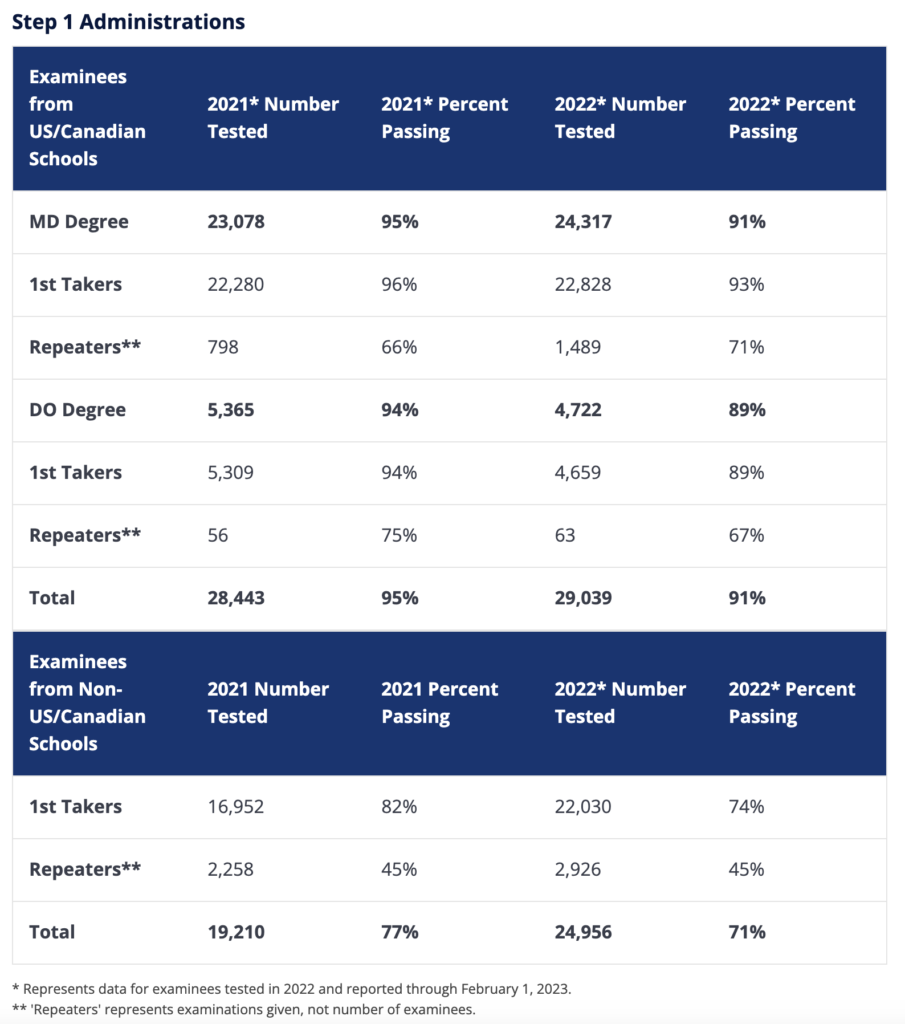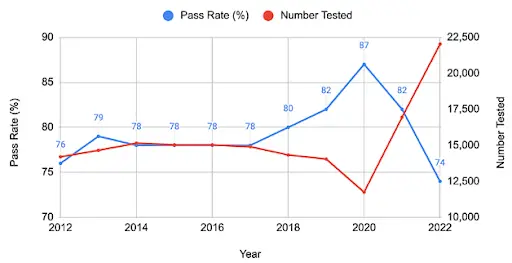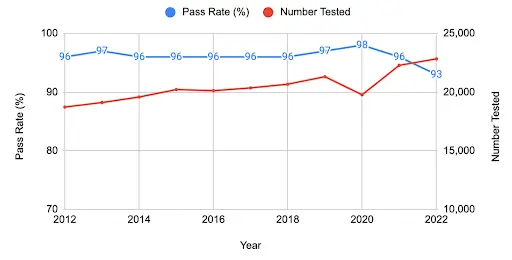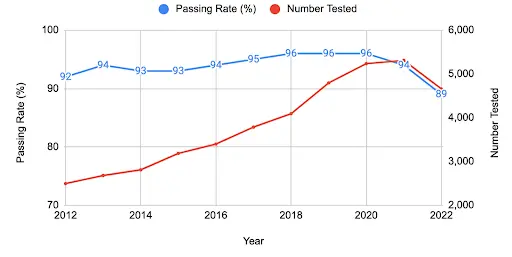The United States Medical Licensing Examination (USMLE) Step 1 has long been a critical milestone for medical students and a determining factor for residency placements. In 2025, the scoring system transitioned from a numerical score to a USMLE step 1 pass/fail system, stirring up waves of curiosity and anticipation among students, educators, and residency program directors alike. This shift aimed to alleviate the pressure and reduce disparities among examinees, yet its impact on test-takers performance has remained a subject of intrigue. In this Article explores, we dive into the data to explore the trends observed among various examinee groups following the introduction of the pass/fail system and discuss potential factors driving these changes.
What is the Minimum Passing Score for USMLE Step 1?
The USMLE Step 1 exam is a critical milestone for medical students, and understanding the pass/fail system is crucial for effective preparation. The USMLE Step 1 Pass/Fail system means that instead of receiving a numerical score, students now receive a designation of either “Pass” or “Fail.”
- Current Passing Criteria: As of the latest update, a score of 196 or higher is required to pass the USMLE Step 1 exam. This score is determined by the USMLE’s psychometric analysis, which ensures the exam maintains its standard for assessing essential medical knowledge.
- Implications of Pass/Fail: While the transition to a USMLE Step 1 Pass/Fail system may reduce stress for some, it also shifts the focus to other aspects of your medical school performance, such as clinical grades and Step 2 scores. Understanding this shift is important for strategic career planning.
- Importance of Passing: A “Pass” in Step 1 is still crucial, as it determines your eligibility to progress in medical training and ultimately enter residency programs. Even without a numerical score, passing Step 1 is a significant achievement and a prerequisite for advancing your medical education.
Implications for Medical Students
The transition to a USMLE Step 1 pass/fail system has several implications for medical students:
- Shift in Focus: Students can now focus on mastering the material rather than aiming for a high score. This encourages a more comprehensive understanding of medical knowledge.
- Residency Applications: Residency programs will place greater emphasis on other aspects of the application, such as USMLE Step 2 CK scores, clinical evaluations, research experience, leadership roles, and personal statements.
- Stress Reduction: The reduction in the high-stakes nature of the exam is expected to alleviate some of the stress and anxiety associated with USMLE Step 1 preparation.
Impact of the USMLE Step 1 New Scoring System on Pass Rates
The transition to a USMLE step 1 pass/fail system has significantly influenced Step 1 pass rates. Prior to this change, from 2017 to 2021, pass rates ranged between 86% and 92%. However, following the 2022 shift to pass/fail, the pass rate dropped to a historic low of 82%, highlighting the increased difficulty of passing the Step 1 exam.
There were concerns among medical students that the pass-fail transition would lead to a higher passing score, but 2022 data did not support this. It was suggested that the challenges in USMLE step 1 pass/fail may be linked to the medical education system, with issues such as unpaid professors, coordination difficulties, and a lack of understanding of students’ knowledge levels or years of study.
Pass Rates in 2025
- 2023 Overall Pass Rate: 87% (up from 82% in 2022)
- MD Degree Exams: 94% (up from 91% in 2022)
- DO Degree Exams: 92% (up from 89% in 2022)
- IMG Exams: 74% (up from 71% in 2022)
While there was an improvement in pass rates in 2023 compared to 2022, they still remain below the pre-pass/fail system rates.
USMLE Step 1 Retake Policy
As of September 2021, students can take the USMLE Step 1 exam up to six times. After a failed attempt, there is a mandatory 60-day waiting period before retaking the exam, with a maximum of three attempts allowed within a 12-month period.
Strategies for Success Under the USMLE Step 1 Pass/Fail System
Although the scoring system has changed, the importance of thorough preparation remains. Here are some strategies to succeed under the USMLE Step 1 pass/fail system:
Develop a Solid Study Plan
Creating a structured and realistic study plan is essential. Break down your study schedule into manageable segments, focusing on different subjects each week. Allocate time for review and practice questions to reinforce your learning.
Sample Study Plan:
- Week 1-4: Focus on basic sciences such as Anatomy, Biochemistry, and Physiology. Use resources like First Aid for the USMLE Step 1 and Pathoma.
- Week 5-8: Move on to organ systems, including Cardiovascular, Respiratory, and Renal systems. Incorporate Kaplan Lecture Notes and UWorld question banks.
- Week 9-12: Concentrate on Pathology, Pharmacology, and Microbiology. Utilize resources like SketchyMedical and BRS Pathology.
- Week 13-16: Integrate all subjects and take full-length practice exams to assess your readiness.
Use High-Yield Resources
Selecting the right study materials is crucial. Here are some highly recommended resources:
- USMLEStrike: A dynamic platform providing tailored study plans, analytics, and test-taking strategies, designed to help students master Step 1 content efficiently and confidently.
- First Aid for the USMLE Step 1: A comprehensive review book that covers high-yield topics and includes mnemonics and clinical correlations.
- UWorld: A question bank with detailed explanations that mimic the format and difficulty of the actual exam.
- Pathoma: A pathology resource with a textbook and video lectures that simplify complex concepts.
- SketchyMedical: Visual learning aids for microbiology, pharmacology, and pathology.
Practice Active Learning
Active learning techniques can enhance your retention and understanding of the material. Some effective strategies include:
- Practice Questions: Regularly practice with question banks like UWorld and Kaplan. Review explanations for both correct and incorrect answers.
- Flashcards: Use spaced repetition systems like Anki to reinforce key concepts and facts.
- Group Study: Join study groups to discuss challenging topics and share different perspectives.
USMLE Step 1 Passing scores in 2025
The passing score for the USMLE Step 1 exam is 196, and achieving this score results in a designation of “pass” on the USMLE Step 1 results. However, in order to reach this passing score, test takers generally need to answer correctly at least 60% of the items on the exam. These minimum passing scores are determined by the USMLE management committee, and they periodically review and update these standards every four years.
Background on the USMLE Step 1 Pass/Fail Scoring Change
The decision to transition the USMLE Step 1 scoring system to USMLE Step 1 pass/fail has been a topic of intense debate among medical educators, students, and residency program directors. Prior to the change, Step 1 scores played a pivotal role in determining residency placements, which led to an unhealthy emphasis on achieving high scores. This hyper-focus on test scores not only contributed to increased stress and anxiety among medical students, but also raised concerns about the potential for overlooking other crucial aspects of medical education, such as clinical skills, communication abilities, and empathy.
The USMLE Step 1 pass/fail scoring system was introduced as a means to address these concerns and promote a more balanced approach to medical education. However, critical thinkers might argue that while this change addresses the issue of test score fixation, it could also inadvertently give rise to new challenges. For instance, residency programs may now struggle to differentiate between applicants without a numerical score, potentially leading them to rely more heavily on other factors or even develop new ranking systems. Consequently, it is essential to examine the impact of the USMLE Step 1 pass/fail transition on examinee performance and its potential implications for the broader medical community.
Data Presentation: Performance of Examinee Groups in 2021 and 2022


Analysis of the Trends: Passing Rates and Test-Taker Numbers
Results
Our examination of performance data for USMLE step 1 pass/fail from 2012 to 2022 has revealed significant trends among individuals taking the test for the first time, hailing from diverse educational backgrounds. We’ve observed distinct patterns among those hailing from non-US/Canadian schools, US/Canadian MD degree programs, and US/Canadian DO degree programs.
Non-US/Canadian schools
Among first-time test takers from non-US/Canadian schools, the pass rate exhibited fluctuations throughout the decade. The rate peaked at 87% in 2020 but experienced a decline to 74% by 2022, coinciding with the transition to a pass/fail scoring system. Interestingly, despite scoring changes, there was a consistent increase in the number of test takers, indicating sustained interest in the examination.

US/Canadian schools (MD degree)
For first-time test takers from US/Canadian MD degree programs, the pass rate remained relatively high, with a minor peak at 98% in 2020. However, there was a noticeable decrease to 93% in 2022. Over the years, there has been a steady rise in the number of test takers, particularly evident from 2020 to 2022, indicating a growing cohort of aspiring physicians.

US/Canadian schools (DO degree)
First-time DO test takers from US/Canadian schools saw a consistent increase in examinees, reaching a peak of 5,309 in 2021. This surge reflects the expanding role and recognition of osteopathic medicine within the healthcare landscape. However, this growth was accompanied by a slight decline in the pass rate, from 92% in 2012 to 89% in 2022.

Comparative Analysis
When comparing the performance of the three groups, test takers from US/Canadian MD degree programs consistently demonstrated higher pass rates throughout the decade. However, all groups experienced a decline in pass rates in 2022, coinciding with the implementation of a USMLE Step 1 pass/fail scoring system for the USMLE Step 1. The most significant relative decline was observed among non-US/Canadian schools’ first-time test takers, with an 8% decrease from 2021 to 2022.
Challenges and Opportunities for Examinees under the USMLE Step 1 Pass/Fail System
| Aspect | Challenges | Opportunities |
|---|---|---|
| Differentiation | Harder to stand out without numerical scores | Promotes holistic approach to medical education |
| Pressure | Pressure shifts to other standardized exams | Reduced stress related to USMLE Step 1 preparation |
| Subjective Factors | Greater reliance on subjective factors in evaluations | Encourages diverse experiences and skill development |
Advice for Students in a Post-Step 1 Score World
Adapting to the USMLE Step 1 Pass/Fail System
- Focus on Clinical Skills and Step 2 CK:
- With Step 1 now pass/fail, your Step 2 CK score has gained more weight in residency applications. Dedicate time to mastering clinical knowledge and achieving a strong score.
- Build a Robust CV:
- Engage in research, extracurricular activities, and leadership roles to stand out. Program directors will prioritize well-rounded candidates who excel beyond test scores.
- Excel in Medical School Courses:
- Many residency programs value medical school grades, particularly in core clinical rotations like internal medicine and surgery.
- Invest in Strong Letters of Recommendation:
- Seek mentorships and develop strong relationships with faculty to secure personalized, impactful recommendation letters.
- Perform Well in Clinical Clerkships:
- Demonstrating dedication and skill in clinical rotations is essential for impressing program directors.
- Prepare for Step 1 with a Passing Mindset:
- Treat USMLE Step 1 Pass/Fail seriously; a “fail” could delay your journey, so prepare with reliable resources to ensure success.
Steps for Success
| Step | Action | Key Focus |
|---|---|---|
| 1 | Understand the Exam | Familiarize yourself with the USMLE Step 1 format and content outline. |
| 2 | Create a Study Plan | Develop a realistic and structured timetable, balancing high-yield resources and practice questions. |
| 3 | Use Trusted Resources | Stick to well-known materials like USMLE Strike, UWorld, First Aid, and Pathoma for consistent learning. |
| 4 | Practice, Practice, Practice | Take NBME self-assessments and timed question blocks to build stamina and identify weak areas. |
| 5 | Prioritize Mental Health | Incorporate breaks and self-care to maintain focus and prevent burnout. |
Conclusion
In this ever-evolving landscape of medical education, our comprehensive USMLE Step 1 course is designed to help you navigate the USMLE Step pass/fail system with ease and confidence. With expert guidance, tailored study materials, and personalized support, our course offers everything you need to succeed. Don’t leave your future to chance – invest in your success today and unlock your full potential with our USMLE Step 1 course. Sign up now and take the first step towards a successful medical career!





